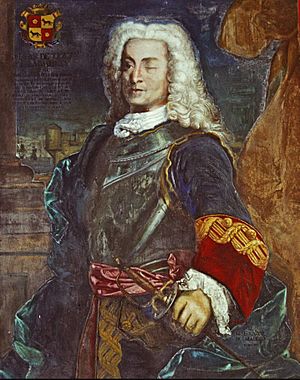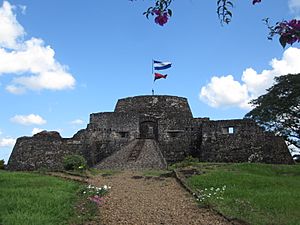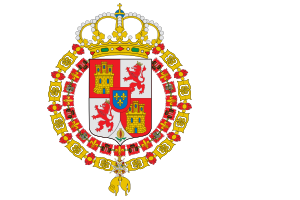Rafaela Herrera facts for kids
Quick facts for kids
Rafaela de Herrera y Torreynosa
|
|
|---|---|
| Born |
Rafaela de Herrera y Torreynosa
August 6, 1742 |
| Died | 1805 (aged 61–62) |
| Nationality | Spanish |
| Known for | Battle for the Río San Juan de Nicaragua (1762) |
| Spouse(s) | Pablo Mora |
| Children | five, names unknown |
Rafaela de Herrera y Torreynosa (1742–1805) was a brave girl born in a Spanish colony. She is known as a national hero of Nicaragua. This is because she bravely defended a fort called the Fortress of the Immaculate Conception in 1762. She fought against British forces during the Battle for the Río San Juan de Nicaragua.
Early Life and Family

Rafaela Herrera was born on August 6, 1742. Her birthplace was Cartagena de Indias. This city was part of the Viceroyalty of New Granada in the Spanish Empire. She was the only child of Lieutenant Colonel Don José de Herrera y Sotomayor and Felipa Torreynosa. Rafaela's birth mother was Felipa Torreynosa. Rafaela was raised by another woman, Doña Maria Felipe de Uriarte.
Rafaela's father was an artillery captain. He had fought hard against British forces in 1741. This was during the Battle of Cartagena de Indias. When Rafaela was born, her father was in charge of the Castillo de San Sebastián del Pastelillo. This was a fort near Cartagena.
Rafaela also came from a family of important military leaders. Her grandfather, Don Juan de Herrera y Sotomayor, was a famous military engineer. He founded a military academy in America. Her great-grandfather, Don José Antonio de Herrera y Sotomayor, was a Governor of Río de la Plata.
Rafaela's father taught her many things. He trained her in military skills, like how to use a cannon. He also taught her about honor, faith, and love for her country. In 1753, Rafaela and her father moved from Cartagena. Her father was assigned to be the commander of the garrison at the Fortress of the Immaculate Conception. This fort was on the San Juan River in Nicaragua.
Defending the San Juan River

The San Juan River was very important. It offered a possible route between the Atlantic and Pacific oceans. This made Spanish Nicaragua a big target for British attacks in the 1700s. In 1762, William Lyttelton, the British governor of Jamaica, planned an attack. His goal was to sail up the San Juan River to Lake Nicaragua. Then, they would capture the town of Granada. This would split Spanish America in half. The main challenge was to capture the Fortress of the Immaculate Conception.
The fighting started in June 1762. A group of Miskito Sambu fighters, helped by the British, attacked farms. They raided many villages in Nicaragua. They burned and looted towns. They also captured Spanish prisoners and sold them into slavery.
In July, the British and Miskito forces moved towards the Fortress of the Immaculate Conception. The attacking force had two thousand men and over fifty boats. The fort had only about one hundred soldiers. To make things worse, the fort's commander, José Herrera (Rafaela's father), was very sick. As he was dying, Rafaela promised him she would defend the fort. Her father died between July 15 and July 17. Lieutenant Don Juan de Aguilar y Santa Cruz took temporary command.
A few days later, on July 26, 1762, the British and Miskito forces attacked the fort. This event is now known as the Battle for the Río San Juan de Nicaragua. Early that morning, a lookout heard cannon fire. The attackers captured an observation post. From Spanish prisoners, the British learned the fort was in chaos. This was because its commander had just died.
Hours later, the British commander demanded the fort surrender. He promised no more fighting if they gave up. The second-in-command was about to agree. But 19-year-old Rafaela Herrera stepped in. She saw the defenders acting scared. Rafaela bravely said, "Have you forgotten your duty? Will you let the enemy steal this fort? It protects Nicaragua and your families!"
Driven by her promise to her father, she strongly refused to surrender. She insisted every soldier fight. She ordered the fort gates locked, took the keys, and placed guards.
The British then formed a battle line. They thought this would be enough to make the fort surrender. But Rafaela, who knew how to use weapons, fired a cannon. With her third shot, she killed the British commander! The British were furious. They raised their flag and attacked the fort fiercely all night. The soldiers inside, inspired by Rafaela, fought back hard. They caused many losses for the British.
At nightfall, Rafaela ordered a clever move. She told the troops to throw sheets soaked in alcohol into the river. These were on floating branches and set on fire. The river current carried the burning material towards the enemy boats. This surprise attack forced the British to stop their attack for the night. The next day, the British tried to surround the fort. But they made little progress and suffered many casualties.
Inspired by Rafaela's bravery, Lieutenant Juan de Aguilar led the defenders to victory. The battle lasted six days. Rafaela handled the cannons. The Spanish not only defended the fort but also defeated a much larger and better-trained enemy. The British finally gave up their attack on August 3, 1762. They retreated to the mouth of the San Juan River.
Soon after, Spain and Britain began peace talks. These talks led to the Treaty of Paris (1763) in February 1763. Under this treaty, Cuba and Manila were returned to Spain. Spain, in turn, gave Florida to the British.
Later Life
Rafaela later married Don Pablo Mora. He was a citizen of Granada. They had five children. Sadly, two of their children were paralyzed. Her husband died after their fifth child was born. Rafaela and her family lived in a poor neighborhood in Granada until 1781.
On November 11, 1781, King Charles III of Spain issued a special order. He granted Rafaela a pension for life. This was a reward for her heroic actions during the battle. She received some land and a pension of 600 pesos. This was to honor her great bravery.
See also
 In Spanish: Rafaela Herrera para niños
In Spanish: Rafaela Herrera para niños
- Women in warfare (1750–1799)
- Timeline of women in early modern warfare


